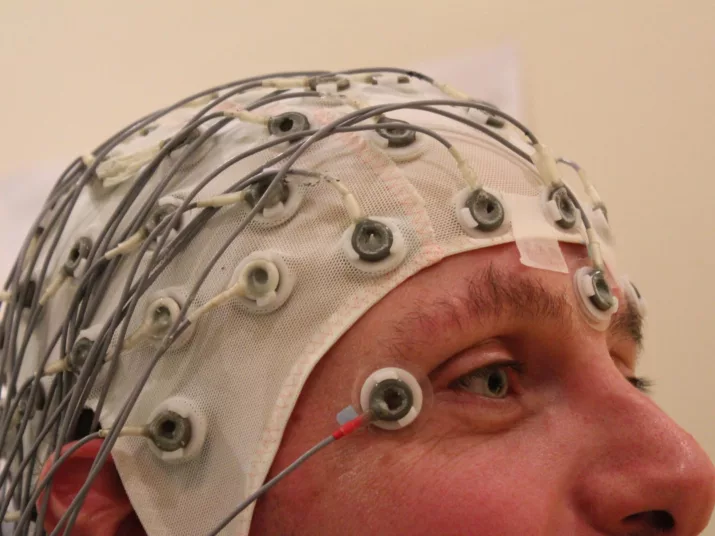
“Mind-reading” as a method of measurement.
Photo: Tim Sheerman-Chase (CC BY 2.0 / https://creativecommons.org/licenses/by/2.0/)
Thinking Space Technology
Decoding our Thoughts
Brain-computer interfaces (BCIs) could facilitate a new level of communication between human and machine. Research in this field, especially in the medical sector, is striding ahead in leaps and bounds. New horizons have already been opened up, for instance in the rehabilitation of stroke patients and in the treatment of epilepsy, Parkinson’s disease or schizophrenia.

“Mind-reading” as a method of measurement.
Photo: Tim Sheerman-Chase (CC BY 2.0 / https://creativecommons.org/licenses/by/2.0/)
But a BCI could also become relevant in other areas of life. Companies in the games, education or lifestyle sectors could use brain signals and other bio-signals to develop and market a variety of applications. How can, should and may the development of BCIs move forward? And which rules do we as a society need to develop for dealing with this technology?
What can a BCI do – and not do?
Brain signals allow us to read a range of mental states, like, for instance, the idea in one’s head that leads to the raising of one’s hand. Since certain thoughts are associated with characteristic patterns, computers can learn to draw conclusions from them. It has already been possible to recognise different types of thought. For example, it’s possible to distinguish whether a test person is thinking about a piece of music or a movement.
But how can the mere thought of music be transformed into a concrete command? To this end, human and machine must work together and agree on a common classification for thoughts and intentions. For example, if the thought connected to the idea of a tennis match is “yes” and the thought connected to a piece of music is “no”, then the answering of simple questions becomes possible.
So far, the machine is unaware of the exact piece of music or the precise movement a human is thinking about. The electrical impulses reveal nothing about the content of our thoughts, feelings or intentions. So mind-reading is likely to remain a science-fiction scenario for the time being.
Technology for the benefit of patients
Accidents, strokes or serious diseases such as ALS (amyotrophic lateral sclerosis, a disease of the nervous system that can lead to complete paralysis of the body) can cause people to lose the ability to move their muscles in a consciously targeted manner. This condition is known as “locked-in syndrome”.
BCIs could enable those affected – despite the advanced state of their disease – to continue interacting with their environment and in this way to continue participating in life.
It’s already possible – using the power of thought alone – to dictate individual letters and even entire sentences by means of an EEG cap (EEG = electroencephalogram) and a device that converts brain waves into screen signals. In 1999, a team of researchers led by the neuroscientist Professor Niels Birbaumer at the University of Tübingen appeared to make the big breakthrough. Here you can find out more about Birbaumer’s research and the controversy currently surrounding it.
Will it be medically and ethically justifiable in the future to go one step further and use brain implants in patients? One popular vision sees paralysed people being enabled with the help of brain implants to control a so-called exoskeleton – a kind of robot suit that supports or reinforces the wearer’s movements – and in this way to be able to walk again. In a nutshell: technologically, almost anything is possible.